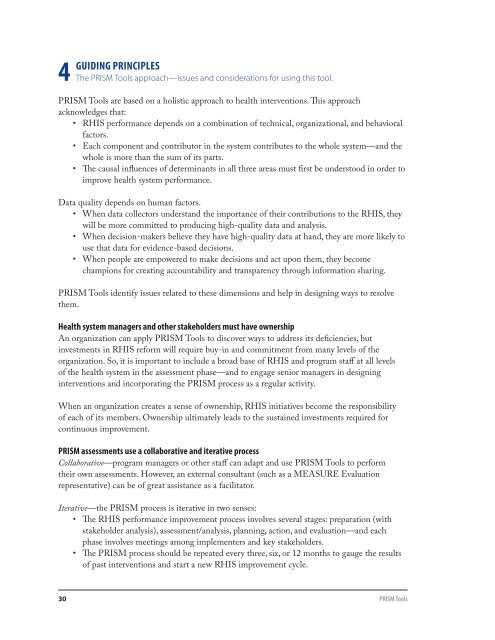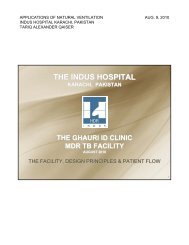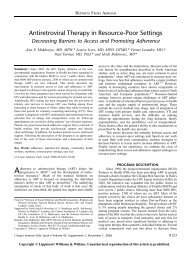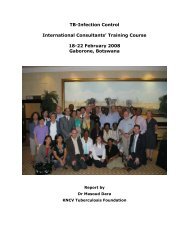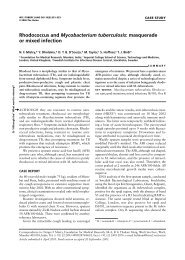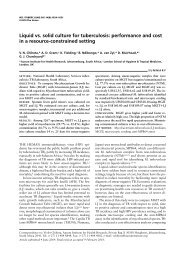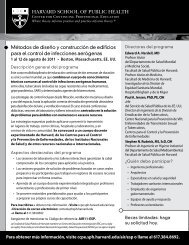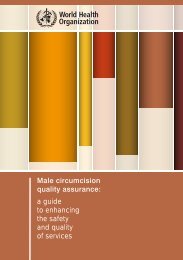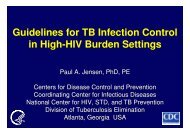PRISM_DescriptionOfTools.pdf - GHDonline
PRISM_DescriptionOfTools.pdf - GHDonline
PRISM_DescriptionOfTools.pdf - GHDonline
You also want an ePaper? Increase the reach of your titles
YUMPU automatically turns print PDFs into web optimized ePapers that Google loves.
4<br />
Guiding Principles<br />
The <strong>PRISM</strong> Tools approach—issues and considerations for using this tool.<br />
<strong>PRISM</strong> Tools are based on a holistic approach to health interventions. This approach<br />
acknowledges that:<br />
• RHIS performance depends on a combination of technical, organizational, and behavioral<br />
factors.<br />
• Each component and contributor in the system contributes to the whole system—and the<br />
whole is more than the sum of its parts.<br />
• The causal influences of determinants in all three areas must first be understood in order to<br />
improve health system performance.<br />
Data quality depends on human factors.<br />
• When data collectors understand the importance of their contributions to the RHIS, they<br />
will be more committed to producing high-quality data and analysis.<br />
• When decision-makers believe they have high-quality data at hand, they are more likely to<br />
use that data for evidence-based decisions.<br />
• When people are empowered to make decisions and act upon them, they become<br />
champions for creating accountability and transparency through information sharing.<br />
<strong>PRISM</strong> Tools identify issues related to these dimensions and help in designing ways to resolve<br />
them.<br />
Health system managers and other stakeholders must have ownership<br />
An organization can apply <strong>PRISM</strong> Tools to discover ways to address its deficiencies, but<br />
investments in RHIS reform will require buy-in and commitment from many levels of the<br />
organization. So, it is important to include a broad base of RHIS and program staff at all levels<br />
of the health system in the assessment phase—and to engage senior managers in designing<br />
interventions and incorporating the <strong>PRISM</strong> process as a regular activity.<br />
When an organization creates a sense of ownership, RHIS initiatives become the responsibility<br />
of each of its members. Ownership ultimately leads to the sustained investments required for<br />
continuous improvement.<br />
<strong>PRISM</strong> assessments use a collaborative and iterative process<br />
Collaborative—program managers or other staff can adapt and use <strong>PRISM</strong> Tools to perform<br />
their own assessments. However, an external consultant (such as a MEASURE Evaluation<br />
representative) can be of great assistance as a facilitator.<br />
Iterative—the <strong>PRISM</strong> process is iterative in two senses:<br />
• The RHIS performance improvement process involves several stages: preparation (with<br />
stakeholder analysis), assessment/analysis, planning, action, and evaluation—and each<br />
phase involves meetings among implementers and key stakeholders.<br />
• The <strong>PRISM</strong> process should be repeated every three, six, or 12 months to gauge the results<br />
of past interventions and start a new RHIS improvement cycle.<br />
30 <strong>PRISM</strong> Tools


